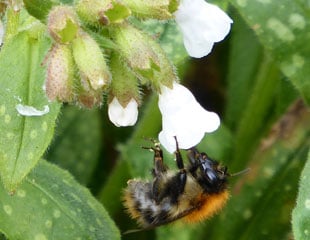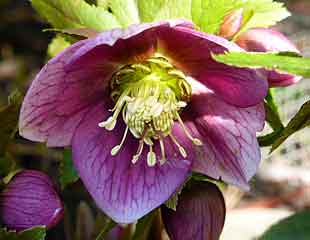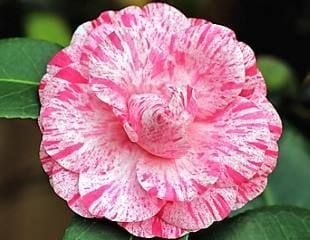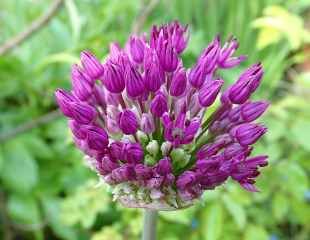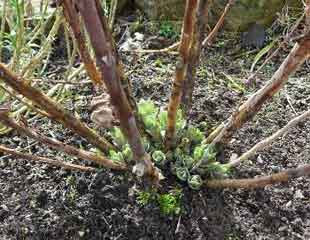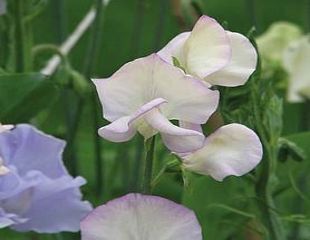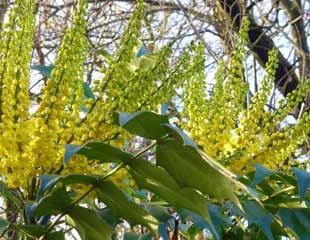What to do in the garden in February
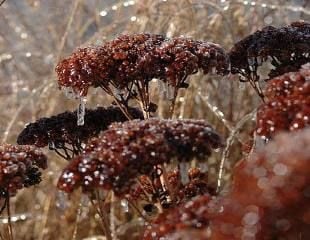
February at a glance
- Pruning time for Clematis, Wisteria, Winter Jasmine, Hydrangea, Buddleia, Cornus, Mahonia, Evergreen shrubs, Climbing and Bush roses.
- Sow early seed under glass with extra heat and light.
- Plant summer flowering bulbs.
- Cut back Sedum and other perennials.
- Sow Sweet Peas.
- Chit Potatoes
- Remove leaves from Hellebores
February in the Garden
Gardening is more than seasonal. Because there are significant variations in conditions across the UK, the rules about what to do in the garden and when are not hard and fast rules. Plus the actual weather moderates gardening advice. No two Springs are ever the same, (who can forget the Beast from the East?)
If you garden in the south of England or have a garden which is sheltered, everything starts earlier. In more northern gardens, especially in exposed plots, some tasks will need to wait perhaps until March. All gardening calendars are just a guide. It depends on your garden and the weather.
During mild spells in February, you can plant shrubs, climbers and bare rooted roses.
Pruning Clematis and Wisteria in February
February is a big pruning month.
February is pruning time for two tricky climbers: Clematis (except Group 1) and Wisteria. Below are links to the advice pages and short videos explaining how to prune both climbers.
Wisteria is more likely to flower if pruned correctly. "How to make Wisteria flower' is one of the most frequently asked questions and here is video on how to prune wisteria, (viewed over 350,000 times, so I hope it is helpful!) and a video on winter prune wisteria.
For Clematis, the first step is to work out to which pruning group the Clematis belongs. This is because pruning requirements vary with different pruning groups for Clematis. Video advice: Clematis pruning groups 1,2 and 3 explained, How to prune Group 2 and Group 3 Clematis.
Want to brighten up your garden in February - shrubs and plants at their best and flowering in February.
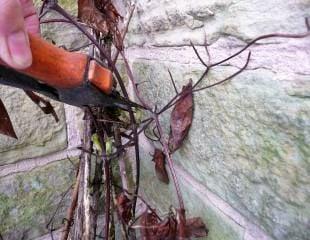
Prune Clematis
In February and early March, during mild spells, prune Clematis groups 2 and 3.
If it's a group 2 Clematis (in short, characterised by large flowers in midsummer) it needs a lighter prune. If it is a group 3 Clematis (flowers bloom from mid to late summer) it's a harder prune. The words "pruning" and "Clematis" are scary, but here is how to make it easy.
Do not routinely prune early flowering Clematis. These are any Clematis which flower between February and May, and they are varieties such as Clematis Montana, Alpina, Armandii and known as Group 1 (see types of Clematis.)
Because these types of Clematis flower early in the year, if you were to prune now, you would cut off the branches carrying the flower buds.( They flower on old wood- what does this mean?) They only need pruning if they get out of control, and then only after flowering.
How do you know if my clematis is a group 2 or 3 and how much to prune it?
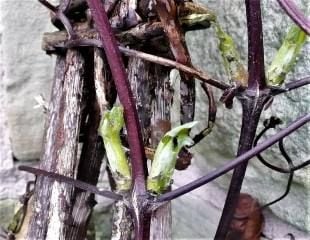
Check out the Sunday Gardener video about Groups 1,2 & 3 which explains the differences between the various Clematis groups so you can decide which it is.
If you don't have the label saying to which group your Clematis belongs, it is a bit of a headache. You have to fall back on the rule of thumb (which the video explains) and which is also explained on the growing Clematis pages.
Broadly speaking, Group 1 flower from very early February up to around May; Group 2 tend to flower in early summer and Group 3 flower late summer.
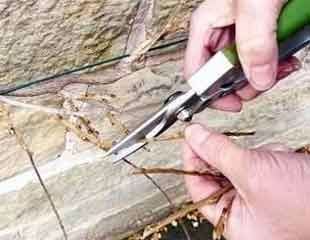
Prune Wisteria
February is also the time to prune that other tricky climbing plant, Wisteria. Follow the links for detailed advice on how to Grow and Prune Wisteria and how to make sure your Wisteria flowers. To get Wisteria to flower, it needs to be pruned twice a year, winter and summer. There is a detailed explanation on the Wisteria page and also video on winter and summer prune. If you want your Wisteria to flower, or it has stopped flowering, get pruning.
More pruning Due In February
February/ March is the correct time to prune several plants and shrubs:-
Climbing and bush roses
Fuchsia, Santolina and Lavatera.
Cut back deciduous grasses.
Over grown shrubs which need renovating.
Do not prune any shrubs which are spring-flowering or you will cut off the potential flowers. Spring flowering shrubs flower on "old wood", - more information about this. We always prune spring flowering shrubs after flowering, usually in the early summer. For more information and a guide to pruning plants and shrubs.
Mahonia is particularly prone to becoming leggy with bare shoots at the base. After flowering, you can cut it back hard.
Remove leaves from Hellebores
By winter, especially late winter, the foliage on Hellebores is looking tired and often tinged with black spot. Removing the old foliage takes away the black spot and enables the new fresh foliage to come through and take centre stage. If you google "when to remove foliage from Hellebores" the results will say anything from December to March.
Like many gardeners, my Hellebores often get attention when I get round to it, which maybe February. The exception would be if the black spot was serious. I then would recommend removing the foliage earlier to destroy the black spot and ensure it does not overwinter in the soil.
If the Hellebores just look a bit of a mess, I suggest cutting the foliage back during January/February. The images below show a "before and after" as when you remove the foliage it looks drastic, but a short time later the Hellebore has recovered well.
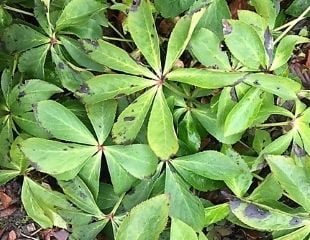
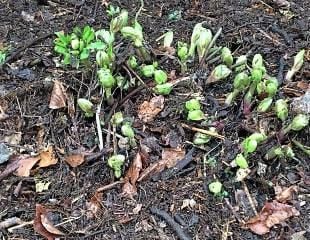
Prune Cornus also known as Dogwood
During a mild spell in Feb/March you can prune Cornus, common name Dogwood, which has brightly coloured stems in the winter. Hard pruning in February helps to ensure good colour in the stems next winter.
Cut the plant back almost to ground level, and be assured it will regrow in the spring. If the hard prune is daunting, check out this video which has a "before" and "after" shot so you can see exactly what needs to be done.
Cornus is a great, easy to grow shrub, red stems in winter and variegated foliage. The pruning offcuts are useful for making plants supports, see free plant supports.
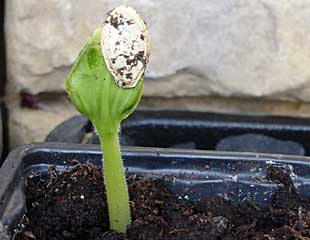
What to sow in February
To germinate seeds this early in the year, it is essential to create a warm, benign environment for germination and for the early stages of the seedlings. Very few gardeners can afford the luxury of a heated greenhouse, which means bringing seed trays into the house, or using a heated propagator mat and site the seed trays in a porch or unheated conservatory. Seeds will need to be placed into a sealed propagator to create a warm atmosphere which will not dry out. Once germinated and established, remove and keep frost free. Light levels are very low in February and plants need to be turned regularly to keep even growth.
The benefits of seeding in February, if all goes well, is that the plants will mature earlier. Sowing in March and April is easier because of the extra light and warmth. Lots of information and advice at How to Sow Plant and Veg Seeds, 10 top tips for successful sowing and germination and what to do with leggy seedlings.
Video advice on sowing seeds and germination.
Suitable for seeding under glass in February are: aubergines, beetroot, chilies, broad beans, lettuce and rocket and tomatoes. Flower seeds, many of the popular garden plants such as Ageratum, Antirrhinum, Calendula, Cornflower, French Marigolds, Nigella, Rudbeckia, Salvia, Scabious, Sweet Peas and Zinnia.
The hardier plants such as Broad Beans, Lettuce, and Sweet peas will be easier to sow early because they will withstand the cooler temperature. Equally, the more tender plants, courgettes, cucumbers, ipomoea may be best left to later.
Towards the end of the month and into March, it is easier to germinate and grow on seeds because of the increasing light and warmth. The further north you are in terms of prevailing weather and chill factor, the more you may wish to delay first sowings.
Plant bulbs for late spring and summer
There are many lovely summer bulbs which, although usually planted in the Autumn, if you missed the slot, early spring provides another opportunity.
Bulbs you can plant now include:
Allium, (illustrated left Allium 'Globemaster') makes a fabulous display and mixes so well with many popular plants. You can plant Alliums in February, which will flower in late spring and early summer.
Allium are easy to grow, lots of images and growing tips. Once established, return reliably each year.
have a lovely selection of Alliums, (affiliate link) including the classic A. giganteum tall with large flowers, the late summer flowering Allium
sphaerocephalon which looks great with grasses, and
the spikey and unusual
Allium schubertii.
Plant Lilies in Feb/March for a great scented display. Lilies dislike heavy soil, which can make them less reliable in subsequent years. If your garden conditions are not ideal with wet heavy clay conditions, it is better to plant in containers popular lilies to grow include L. Stargazer, Casablanca and the beautiful 'Lotus Elegance'
You can plant Anemone now. The corms (bulbs) are best soaked overnight before planting. There are lots of summer flowering bulbs in the garden centres from now onwards. Check the packets carefully as not all are fully hardy. Those which are not frost hardy need to be planted later or protected from frost. The best chance of ensuring summer bulbs flower the following year is to feed them during the growing season, right up to flowering. A Tomato feed is ideal.
This is also planting time for crocosmia to flower in late summer. Crocosmia is easy to grow and returns reliably each year. Some varieties can be invasive, which is not uncommon, with some easy to grow plants. At the end of the season, when the crocosmia is dying back, I pull/tug and dig out some new growth along the edges of the patch to keep it in check.
Cut back Sedums and other perennials
February presents as a turning corner to-wards spring and although the garden appears dormant, there is growth at ground level with tiny buds and shoots appearing. The image shows early growth on a Sedum, reminding us what lies ahead. February is an ideal time to cut back the old top growth. By doing it early, you avoid damaging the new growth coming through. Cutting back later is more difficult because it is harder to cut back without damaging the new growth.
Sow Sweet Peas
From February onwards, it's time to sow sweet peas. Sweet peas are a half-hardy annual and will withstand a good amount of chill and even frost. They are hardy to -5 as long as the ground is not too wet.
Showy and scented, sweet peas are ideal for climbing up an obelisk or fence and make great as cut flowers. YouTube Video how to sow sweet peas. Illustrated is Sweet Pea 'High Scent', which, as the name implies, is a strongly scented variety. Sweet peas need a fair amount of attention and for long, straight stems, you need to know about the tendrils and how to remove them. Advice on how to grow sweet peas from seed and growing tips. Video on how to plant sweet peas.
Prune Mahonia
Prune Mahonia when it has finished flowering. If the Mahonia is looking healthy, with lots of growth and is in good shape, prune it by simply removing the spent flowers. If it is a little straggly, prune out the long shoots and tidy up.
However, as it matures, Mahonia has a tendency to become leggy with bare stems at the base of the plant, which requires a hard prune. How to renovate a Mahonia.
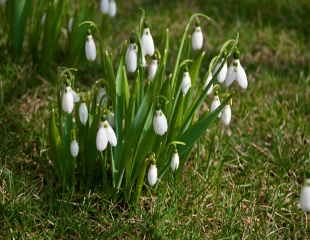
Divide and plant Snowdrops
If you want to bulk up your snowdrop display for next year, now is the time to plant snowdrops in the green, or to divide up mature clumps.
Plant to the same depth so that the white part of the stem in under the soil and the leaves and flower above. Water well to get established for next year.
Prune Rosa Rugosa
In February you can prune Rosa Rugosa, with care, as they have very prickly stems. Take out the oldest shoots at ground level and a half of the rest for a good display of flowers and hips later in the year. Rosa Rugosa is suitable to grow in a coastal garden for more ideas of plants and shrubs which tolerate sea side condition check out plants for coastal gardens.
Prune Evergreen Shrubs
If you want to tidy up or reduce the size of evergreen shrubs, you can prune in February. In a mixed border, pruning the lower stems of the shrubs nearer the ground lifts the canopy to allow more light for plants close to or under the shrub.
Plants which flower on last year's growth need to be pruned later, after flowering, which is usually later spring/summer not late winter/spring; otherwise, you will cut off the stems on which flower buds are forming.
Whilst it's tempting to prune in early spring as the garden comes awake, each shrub is different, and bears checking out individually. Pruning at the wrong time can be the answer to why a shrub doesn't flower as expected.
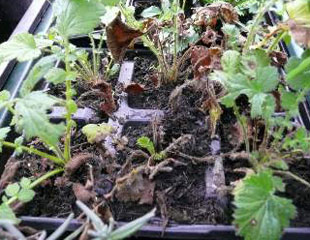
Mould in the Greenhouse
Late winter is the time there can be problems in the greenhouse, as the image left, which shows a mould attack. Botrytis is also known as grey mould. This frequently occurs in the winter when the days are cold and damp, especially the damp.
To try to prevent grey mould, watering sparingly, (which is essential in the winter) the lack of sun allows the air to remain cold and damp, which is a threat to the plants. Check the greenhouse plants regularly, physically feel the soil and don't water unless it is dry, which may only be monthly or less. On Mild winter days, open up the greenhouse doors and manual vents to let as much air in as possible. If you get an attack of mould, cut off all infected leaves and if it is severe, move the plant out of the greenhouse to prevent the spread of infection.
February in the Veg plot
Is it too early to sow?
In some parts of the country, in the south and sheltered gardens, February is the right time to prepare the veg plot by warming up the soil ready for early plantings. Do this by either covering the plot with polythene (well pegged down to be secure in the event of gales) or with cloches. If this is too much faff, just wait a month or so, and let do the sun do the warming for you.
If you are a keen gardener and in a sheltered spot, it is possible to start some veg growing but only a few and specific named varieties. Only plant during a mild spell and protect with cloches. There are some very hardy Broad beans, such as Aquadulce Claudia. Also, garlic can be planted in with light soil. Some garlic is suitable for autumn planting and some for spring, so you need to check the variety and also there is a soft neck and hard neck. Garlic is easy to grow and can even be grown in between other veg, and in pots. Importantly, garlic needs a light soil and lots of sun.
You can germinate, under glass, hardier varieties of Peas, Beetroot, (the Boltardy variety would be suitable) and radishes. You can start lettuces in the greenhouse, such as the cut and come again varieties, and rocket. Also propagate (with heat) leeks, cabbages, Brussels and chilies which need a long growing season. Remember, once germinated, the seedlings will need to continue growing under glass or frost free until all risk of frost has passed. If space is a problem, it's sometimes easier to germinate later when the weather is better.
Time to start Potatoes
February is also the time to chit potatoes ready for planting out in the spring. Place them in a cool and light area and from the "eyes" shoots will form over the next few weeks until planting out. This is said to help get the potatoes off to a good start. Don't worry if there is not time to do this before planting, as the jury is out on how much good chitting actually does.
High levels of blight have been a problem in wet summers. It's hard to avoid, but there are varieties of potato which are blight resistant, such as the Sarpo varieties. Another possibility is to grow early cropping potatoes such as Charlotte, Pink Fir, Rocket, Anya (all sold in garden centres and on line) which may crop before the blight arrives.
Chitting Potatoes
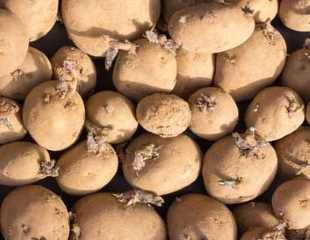
Broad bean in root trainer
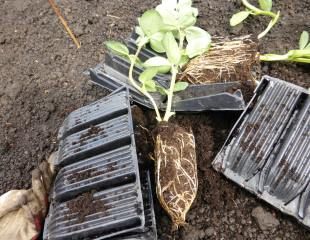
Before cutting back
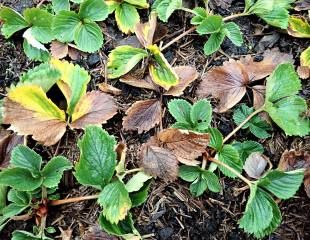
Look after strawberries
Strawberries are a hardy perennial, which means by late winter they can look a bit tired. This is a good time to remove the old brown foliage to encourage fresh growth and to let in more light. This also reduces disease and more air circulation, which helps to keep botrytis at bay later in the year.
If you want to get an early crop of Strawberries cloche them later this month/early March, but remember to water under the cloches periodically.

